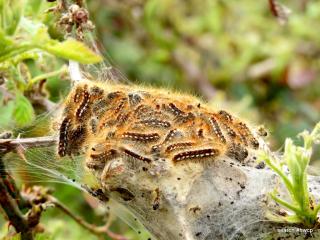Browntail Moth Information

How the Browntail Moth Can Affect Employees/People:
The Browntail moth is an invasive one. It was accidentally introduced to the U.S. in 1897 and now is only found on the coast of Maine and on Cape Cod. They nest by the hundreds in winter webs in the tops of trees. These nests are only 3 to 5 inches in size and look like clumps of dead leaves. Browntail moths cause the most damage when they are caterpillars. When they are caterpillars, they eat the leaves of oak and apple trees, but they can infest other trees. These caterpillars have microscopic poisonous hairs that can cause a blistery, oozy rash similar to poison ivy and can lead to respiratory problems for some people. The hairs don't just go away when the caterpillars do; the toxins in those hairs can stay for a year or more. They also strip trees of their leaves and can eventually kill the tree. This can affect employees who work outside and may come into contact with these hairs.
What to do?
Avoid outside areas that are known to be infested with caterpillars.
Dry laundry inside, not outside, to avoid having the hairs attach to clothing.
Wipe down outside furniture before sitting in it.
Wear protective clothing when mowing, raking, or removing browntail moth webs
Consult a physician if you develop a severe reaction to the caterpillar hairs.
Take a cool shower and change clothing after any activity that might involve contact with the hairs.
If you do have contact, wash it off as soon as possible. If you have breathing problems, consider wearing a respirator or a mask.

